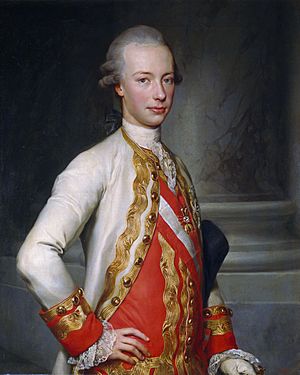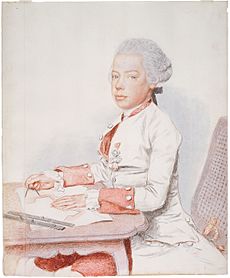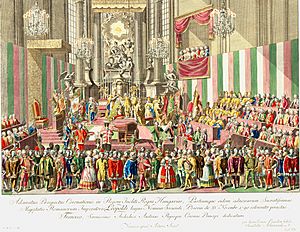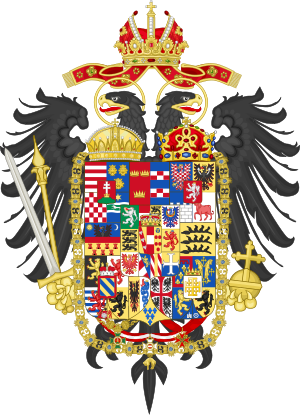Leopold II, Holy Roman Emperor facts for kids
Quick facts for kids Leopold II |
|||||
|---|---|---|---|---|---|

Leopold as Grand Duke of Tuscany, 1770
|
|||||
| Holy Roman Emperor (more...) | |||||
| Reign | 30 September 1790 – 1 March 1792 | ||||
| Proclamation | 9 October 1790, Frankfurt | ||||
| Predecessor | Joseph II | ||||
| Successor | Francis II | ||||
| Governors (in Habsburg Netherlands) |
See list
Maria Christina of Austria & Albert Casimir, Duke of Teschen (1790-1792)
|
||||
| Grand Duke of Tuscany | |||||
| Reign | 18 August 1765 – 22 July 1790 | ||||
| Predecessor | Francis II Stephen | ||||
| Successor | Ferdinand III | ||||
| Born | 5 May 1747 Vienna, Austria, Holy Roman Empire |
||||
| Died | 1 March 1792 (aged 44) Vienna, Austria, Holy Roman Empire |
||||
| Burial | Imperial Crypt | ||||
| Spouse | |||||
| Issue |
|
||||
|
|||||
| House | Habsburg-Lorraine | ||||
| Father | Francis I, Holy Roman Emperor | ||||
| Mother | Maria Theresa of Hungary and Bohemia | ||||
| Religion | Roman Catholicism | ||||
| Signature |  |
||||
Leopold II (born Peter Leopold Josef Anton Joachim Pius Gotthard; 5 May 1747 – 1 March 1792) was an important ruler in Europe. He was the Holy Roman Emperor, King of Hungary and Bohemia, and Archduke of Austria from 1790 to 1792. Before that, he was the Grand Duke of Tuscany from 1765 to 1790.
Leopold was the son of Empress Maria Theresa and Emperor Francis I. He was also the brother of Marie Antoinette, who became Queen of France. Leopold believed in ruling wisely for his people. He is especially remembered for abolishing the death penalty in Tuscany in 1786. This made Tuscany the first modern nation to do so. Even though he ruled for a short time, many historians consider him a very smart and sensible leader.
Contents
Early Life and Education

Leopold was born in Vienna, Austria. He was the third son of his parents. At first, his family planned for him to become a priest, so he studied theology.
In 1753, he was engaged to Maria Beatrice d'Este. She was supposed to inherit the Duchy of Modena. However, this marriage never happened. Maria Beatrice later married Leopold's brother, Archduke Ferdinand.
When his older brother, Archduke Charles, died in 1761, Leopold's path changed. The family decided that Leopold would become the next Grand Duke of Tuscany. This was a special arrangement where the second-born son received a territory and title. On 5 August 1765, Leopold married Maria Luisa of Spain, the daughter of Charles III of Spain. When his father, Francis I, died on 18 August 1765, Leopold officially became the Grand Duke of Tuscany.
Ruling Tuscany: Grand Duke Leopold

For the first five years, Leopold had little real power in Tuscany. He was supervised by advisors chosen by his mother. In 1770, he traveled to Vienna to ask for more control. He returned to Florence with the freedom to rule as he wished.
For the next twenty years, Leopold worked hard to improve his small state. He removed old rules that limited business and personal freedom. He also created a fairer tax system, which lowered taxes for many. He invested in public projects, like draining marshlands, which helped the economy.
Leopold did not have an army to support. He even got rid of the small navy that Tuscany used to have. This meant he could use all the state's money to improve his country. Leopold was not always popular with his people. He was a quiet and private person. He lived simply, though he could be grand when needed. Some people who benefited from the old system did not like his changes.
However, his steady and smart leadership brought great wealth to Tuscany. He tried to change the church's power, but this was less successful. He could not fully take control of church property or put the clergy under state rule.
One of his most famous reforms was abolishing the death penalty. On 30 November 1786, Leopold made a new law that ended capital punishment. He even ordered all execution tools to be destroyed. Torture was also banned. This was the first time a modern state permanently abolished the death penalty.
Leopold also supported science and education. He expanded a museum called La Specola with medical wax models. This was to help people learn about natural laws. He also worked on a new political constitution. This document was very advanced for its time, similar to the Virginia Declaration of Rights in America. It focused on citizens' rights and a balance of power in government. However, it was too new and faced opposition, so it was not fully put into practice before he left Tuscany.
Leopold made many social and economic improvements. He made Smallpox vaccinations widely available. He also created an early center for helping young lawbreakers. Leopold also changed how people with mental illness were treated. In 1774, he introduced a law that allowed people with mental illness to be hospitalized. He built a new hospital, the Bonifacio Hospital. He chose a young doctor, Vincenzo Chiarugi, to lead it. Chiarugi and his team introduced kind and humane rules for treating patients. They banned chains and physical punishment. They are seen as early leaders in the "moral treatment" movement for mental health.
Towards the end of his rule in Tuscany, Leopold became worried about problems in his family's other lands, like Germany and Hungary. These problems were caused by his brother Joseph II's strict rule. Leopold and Joseph II cared deeply for each other. They often met, and a portrait by Pompeo Batoni shows their strong resemblance. But Leopold was very practical. He knew he would have to take over from his brother, who had no children. He did not want to inherit Joseph's unpopularity. So, when Joseph asked him to come to Vienna and rule with him in 1789, Leopold avoided it.
Leopold was still in Florence when Joseph II died on 20 February 1790. He left Tuscany on 3 March 1790. Following the rule that had made him Grand Duke, Leopold gave Tuscany to his younger son, Ferdinand III. Ferdinand ruled Tuscany until 1797 and again from 1814 to 1824.
Becoming Holy Roman Emperor
When Leopold became the Holy Roman Emperor, he immediately made changes to calm the people who were upset by his brother's reforms. He recognized the different regions of his empire as important parts of the monarchy. He made peace with the Hungarians and Bohemians. He also dealt with the rebels in the Austrian Netherlands (now Belgium) by offering them some power. When this did not work, he sent troops to restore order. He also brought back the historic rights of the Flemings. However, he kept some of the changes that his mother and brother had made to strengthen the state. For example, he insisted that no papal bull (a special order from the Pope) could be published in his lands without his permission. One difficult decision Leopold made was to force thousands of Bohemian serfs, who had been freed by his brother, back into servitude in May 1790. This was to please the noble families.
Leopold was Holy Roman Emperor for only two years. During this time, he faced dangers from both the west and the east. In the west, the French Revolution was growing. It threatened the life of his sister, Marie Antoinette, the Queen of France. It also risked spreading revolutionary ideas to his own lands. His sister sent him urgent pleas for help. Royalist supporters who had fled France also tried to convince him to intervene with military force.
From the east, he faced threats from the powerful Catherine II of Russia and the clever policies of Prussia. Catherine wanted Austria and Prussia to get involved in a war against the French Revolution. While they were busy, she planned to take over parts of Poland and gain land from the Ottoman Empire. Leopold II saw through Catherine's plans and refused to be tricked.
He gave his sister good advice and promised help if she and her husband could escape Paris. He refused to meet with the French royalists who kept bothering him. Leopold was secretly pleased that France's power was weakening due to its internal problems. Six weeks after becoming emperor, he showed his disregard for France's weakness. He almost canceled the alliance treaty that his mother had made in 1756. He began talks with Great Britain to limit the power of Russia and Prussia.
Leopold put pressure on Great Britain by threatening to give his part of the Low Countries to France. Once he was sure of British support, he was able to stop Prussia's plans. He met with Frederick William II in July 1790. They made an agreement that was a setback for Prussia. Leopold was crowned King of Hungary on 11 November 1790. Before this, he made a deal with the Hungarian assembly, recognizing the important position of the Magyars. He had already made an eight-month truce with the Turks in September. This paved the way for ending the war that Joseph II had started. With peace in his eastern lands, Leopold could restore order in Belgium and strengthen ties with Britain and the Netherlands.
In 1791, Leopold became more focused on France. In January, he had to firmly send away the Count of Artois, a French royalist. He found the French royalists foolish and tried hard to avoid getting involved in France's problems. However, the insults to Louis XVI and Marie Antoinette during their attempted flight to Varennes in June angered him. He then called on other European rulers to take action. He said the events in France "immediately compromised the honour of all sovereigns, and the security of all governments." Still, he was most interested in peace talks with Turkey. These talks led to a final peace treaty, the Treaty of Sistova, signed in August 1791.
On 25 August 1791, he met the King of Prussia at Pillnitz Castle. They created the Declaration of Pillnitz. This statement said they were ready to intervene in France if other European powers asked for help. This declaration was mostly a formality. Leopold knew that neither Russia nor Britain was ready to act. He tried to prevent the French royalists from using the declaration for their own goals. Despite the strong reaction in France to the Declaration of Pillnitz, Leopold still hoped that military intervention might not be needed. When Louis XVI agreed to the French constitution in September 1791, Leopold thought a solution had been found. However, attacks on the rights of German princes and the growing violence of revolutionary groups in Paris soon showed that this hope was false. Leopold wanted to face the French revolutionaries with dignity. But the Declaration of Pillnitz actually helped make the political movement in France more extreme.
Like his parents, Leopold had sixteen children. His oldest son, Francis II, became his successor. Several of his other sons became important figures. These included Ferdinand III, Grand Duke of Tuscany, Archduke Charles, Duke of Teschen (a famous soldier), Archduke John of Austria (also a soldier), Archduke Joseph, Palatine of Hungary, and Archduke Rainer (Viceroy of Lombardy-Venetia).
Leopold died suddenly in Vienna in March 1792.
Supporting the Arts
As a supporter of the arts, Leopold II had a big impact on culture in Tuscany and Vienna. He especially loved Italian opera in Florence. When he was Grand Duke of Tuscany (1765-1790), he strongly supported the composer Tommaso Traetta. He helped pay for many new and exciting operas by Traetta, including the first performance in Florence of Traetta's 1763 opera Ifigenia in Tauride. He also supported opera singers like Giovanni Manzuoli, Giusto Fernando Tenducci, and Tommaso Guarducci.
When he became Holy Roman Emperor in 1790, Leopold II brought his love for Florentine opera to the Vienna court. He brought many musicians and opera singers from Tuscany to Vienna. Many artists who were already at the Vienna court, like the writer Lorenzo Da Ponte, were dismissed. Leopold II significantly changed the artists working for the Vienna court.
Before Leopold II, opera buffa (comic opera) was popular in Vienna. But after he became emperor, Leopold directed that opera seria (serious opera) and ballet become the main performances at the Burgtheater and Kärntnertortheate. Because of this change, Mozart, who had written comic operas like The Marriage of Figaro (1786) and Don Giovanni (1787), then created the serious opera La clemenza di Tito. This opera was requested for Leopold's coronation as King of Bohemia in Prague on 6 September 1791. This focus on serious opera and ballet continued in Vienna for decades after Leopold II's reign.
Family and Children
Leopold's mother, Empress Maria Theresa, was the last ruler from the old Habsburg family line. She had 16 children. His brother Joseph II died without any children who survived. But Leopold also had 16 children, just like his mother. He became the founder of the main line of the House of Habsburg-Lorraine.
Here are his children with his wife Maria Luisa of Spain:
| Name | Birth | Death | Notes |
|---|---|---|---|
| Archduchess Maria Theresa | 14 January 1767 | 7 November 1827 (aged 60) | Married Anton I of Saxony in 1787. They had no children who survived. |
| Francis II, Holy Roman Emperor | 12 February 1768 | 2 March 1835 (aged 67) | Married four times. He had children with his second wife, Princess Maria Teresa of Naples and Sicily. Francis II was the last Holy Roman Emperor. |
| Ferdinand III, Grand Duke of Tuscany | 6 May 1769 | 18 June 1824 (aged 55) | Married twice. He had children with his first wife, Princess Luisa of Naples and Sicily. |
| Archduchess Maria Anna | 22 April 1770 | 1 October 1809 (aged 39) | Never married. She became an Abbess (head of a convent) in Prague. |
| Archduke Charles | 5 September 1771 | 30 April 1847 (aged 75) | Married Henrietta of Nassau-Weilburg in 1815. They had children. |
| Archduke Alexander Leopold | 14 August 1772 | 12 July 1795 (aged 22) | Never married. He died in an accident during a fireworks show. |
| Archduke Albrecht Johann Joseph | 19 September 1773 | 22 July 1774 (aged 10 months) | Died as a baby. |
| Archduke Maximilian Johann Joseph | 23 December 1774 | 10 March 1778 (aged 3) | Died as a young child. |
| Archduke Joseph | 9 March 1776 | 13 January 1847 (aged 70) | Married three times. He had children with his second and third wives. He and his eldest son were the last two Counts Palatine of Hungary. |
| Archduchess Maria Clementina | 24 April 1777 | 15 November 1801 (aged 24) | Married the Duke of Calabria. She had one surviving child. |
| Archduke Anton | 31 August 1779 | 2 April 1835 (aged 55) | Never married. He became Grand Master of the Teutonic Order. |
| Archduchess Maria Amalia | 17 October 1780 | 25 December 1798 (aged 18) | Never married. |
| Archduke John | 20 January 1782 | 11 May 1859 (aged 77) | Married Anna Plochl in 1829. They had children. |
| Archduke Rainer | 30 September 1783 | 16 January 1853 (aged 69) | Married Princess Elisabeth of Savoy-Carignan in 1820. They had children. |
| Archduke Louis | 13 December 1784 | 21 December 1864 (aged 80) | Never married. |
| Archduke Rudolph | 8 January 1788 | 24 July 1831 (aged 43) | Never married. He became an Archbishop and later a Cardinal. |
Images for kids
See also
 In Spanish: Leopoldo II del Sacro Imperio Romano Germánico para niños
In Spanish: Leopoldo II del Sacro Imperio Romano Germánico para niños
- Kings of Germany family tree







